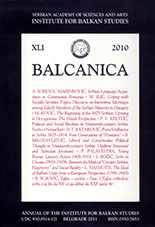Serbs in Croatia (1918-1929): Between the Myth of “Greater-Serbian Hegemony” and Social Reality
Serbs in Croatia (1918-1929): Between the Myth of “Greater-Serbian Hegemony” and Social Reality
Author(s): Sofija BožićSubject(s): History
Published by: Balkanološki institut - Srpska akademija nauka i umetnosti
Keywords: Kingdom of SCS/Yugoslavia; Serbs; Croatia; ethnic relations; political ide-ologies; society
Summary/Abstract: The situation of the Serbian community in Croatia in the years following the 1918 unification has been analyzed in order to test whether the clichéd view of Croatia and Croats as having been endangered and exploited had any impact on the status of the Serbian community and, if it did, in what way. Although the topic is far from being exhausted in this contribution, the examples given suggest that the two nations in Croatia were deeply divided. The sources studied cast quite a different light on the thesis that Croats were “oppressed” by Serbs, a thesis that has for quite a long time been passing as a valid historical interpretation in historiography. These sources suggest that the perception of Serbs as hegemonyminded resulted from propaganda rather than from the actual state of affairs. Besides, they show that the Serbs - systematically portrayed to the Croatian public as invaders and enslavers, while, by contrast, they saw themselves as being “thirdrate citizens” - lived their daily lives under strain, surrounded by intolerance, subjected to various forms of pressure and violence, often fearing for their livelihoods, even for their lives. The inexorable logic of facts leads to the conclusion that members of the Serbian community in Croatia felt discriminated against and not quite safe.
Journal: BALCANICA
- Issue Year: 2010
- Issue No: 41
- Page Range: 185-208
- Page Count: 24
- Language: English

